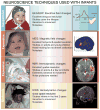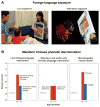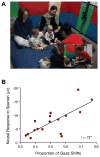Brain mechanisms in early language acquisition
- PMID: 20826304
- PMCID: PMC2947444
- DOI: 10.1016/j.neuron.2010.08.038
Brain mechanisms in early language acquisition
Abstract
The last decade has produced an explosion in neuroscience research examining young children's early processing of language. Noninvasive, safe functional brain measurements have now been proven feasible for use with children starting at birth. The phonetic level of language is especially accessible to experimental studies that document the innate state and the effect of learning on the brain. The neural signatures of learning at the phonetic level can be documented at a remarkably early point in development. Continuity in linguistic development from infants' earliest brain responses to phonetic stimuli is reflected in their language and prereading abilities in the second, third, and fifth year of life, a finding with theoretical and clinical impact. There is evidence that early mastery of the phonetic units of language requires learning in a social context. Neuroscience on early language learning is beginning to reveal the multiple brain systems that underlie the human language faculty.
2010 Elsevier Inc. All rights reserved.
Figures







References
-
- Abramson AS, Lisker L. Discriminability along the voicing continuum: cross-language tests. Proc Int Congr Phon Sci. 1970;6:569–573.
-
- Adolphs R. Cognitive neurosciences of human social behavior. Nat Rev Neurosci. 2003;4:165–178. - PubMed
-
- Aslin RN, Mehler J. Near-infrared spectroscopy for functional studies of brain activity in human infants: promise, prospects, and challenges. J Biomed Opt. 2005;10:11009. - PubMed
-
- Baldwin DA. Understanding the link between joint attention and language. In: Moore C, Dunham PJ, editors. Joint Attention: Its Origins and Role in Development. Hillsdale, NJ: Lawrence Erlbaum Associates; 1995. pp. 131–158.
-
- Baptista LF, Petrinovich L. Song development in the white-crowned sparrow: social factors and sex differences. Anim Behav. 1986;34:1359–1371.
Publication types
MeSH terms
Grants and funding
LinkOut - more resources
Full Text Sources

